
Forage fish
Encyclopedia
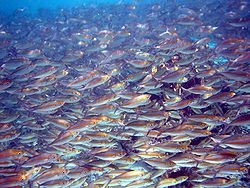
Fish
Fish are a paraphyletic group of organisms that consist of all gill-bearing aquatic vertebrate animals that lack limbs with digits. Included in this definition are the living hagfish, lampreys, and cartilaginous and bony fish, as well as various extinct related groups...
which are preyed on by larger predators for food. Predators include other larger fish, seabird
Seabird
Seabirds are birds that have adapted to life within the marine environment. While seabirds vary greatly in lifestyle, behaviour and physiology, they often exhibit striking convergent evolution, as the same environmental problems and feeding niches have resulted in similar adaptations...
s and marine mammal
Marine mammal
Marine mammals, which include seals, whales, dolphins, and walruses, form a diverse group of 128 species that rely on the ocean for their existence. They do not represent a distinct biological grouping, but rather are unified by their reliance on the marine environment for feeding. The level of...
s. Typical ocean forage fish feed near the base of the food chain on plankton
Plankton
Plankton are any drifting organisms that inhabit the pelagic zone of oceans, seas, or bodies of fresh water. That is, plankton are defined by their ecological niche rather than phylogenetic or taxonomic classification...
, often by filter feeding
Filter feeder
Filter feeders are animals that feed by straining suspended matter and food particles from water, typically by passing the water over a specialized filtering structure. Some animals that use this method of feeding are clams, krill, sponges, baleen whales, and many fish and some sharks. Some birds,...
. They include the fishes of the family Clupeidae
Clupeidae
Clupeidae is the family of the herrings, shads, sardines, hilsa and menhadens. It includes many of the most important food fishes in the world.-Description and biology:...
(herring
Herring
Herring is an oily fish of the genus Clupea, found in the shallow, temperate waters of the North Pacific and the North Atlantic oceans, including the Baltic Sea. Three species of Clupea are recognized. The main taxa, the Atlantic herring and the Pacific herring may each be divided into subspecies...
s, shad
Shad
The shads or river herrings comprise the genus Alosa, fish related to herring in the family Clupeidae. They are distinct from others in that family by having a deeper body and spawning in rivers. The several species frequent different areas on both sides of the Atlantic Ocean, Mediterranean Sea....
, sardine
Sardine
Sardines, or pilchards, are several types of small, oily fish related to herrings, family Clupeidae. Sardines are named after the Mediterranean island of Sardinia, around which they were once abundant....
s, hilsa
Hilsa
Ilish , also spelled Elish, is the most popular fish to Bengalis. Its the national fish of Bangladesh and extremely popular in parts of India such as West Bengal, Orissa, Tripura, Assam as well. Ilish also can be found at India's Assamese-, Bengali- Oriya-speaking regions and in Telugu-speaking...
, menhaden
Menhaden
Menhaden, also known as mossbunker, bunker and pogy, are forage fish of the genera Brevoortia and Ethmidium, two genera of marine fish in the family Clupeidae.-Description:...
and sprats), as well as anchovies, capelin
Capelin
The capelin or caplin, Mallotus villosus, is a small forage fish of the smelt family found in the Atlantic and Arctic oceans. In summer, it grazes on dense swarms of plankton at the edge of the ice shelf. Larger capelin also eat a great deal of krill and other crustaceans...
and halfbeak
Halfbeak
The halfbeaks are a geographically widespread and numerically abundant family of epipelagic fish inhabiting warm waters around the world. The family Hemiramphidae is divided into two subfamilies, the primarily marine Hemiramphinae and the freshwater or estuarine Zenarchopterinae...
s.
Forage fish compensate for their small size by forming schools
Shoaling and schooling
In biology, any group of fish that stay together for social reasons are said to be shoaling , and if, in addition, the group is swimming in the same direction in a coordinated manner, they are said to be schooling . In common usage, the terms are sometimes used rather loosely...
. Some swim in synchronised grids with their mouths open so they can efficiently filter plankton. These schools can become immense shoals which move along coastlines and migrate
Fish migration
Many types of fish migrate on a regular basis, on time scales ranging from daily to annually or longer, and over distances ranging from a few metres to thousands of kilometres...
across open oceans. The shoals are concentrated fuel resources for the great marine predators. The predators are keenly focused on the shoals, acutely aware of their numbers and whereabouts, and make migrations
Fish migration
Many types of fish migrate on a regular basis, on time scales ranging from daily to annually or longer, and over distances ranging from a few metres to thousands of kilometres...
themselves that can span thousands of miles to connect, or stay connected, with them.
The ocean primary producers, mainly contained in plankton
Plankton
Plankton are any drifting organisms that inhabit the pelagic zone of oceans, seas, or bodies of fresh water. That is, plankton are defined by their ecological niche rather than phylogenetic or taxonomic classification...
, produce food energy from the sun and are the raw fuel for the ocean food webs. Forage fish transfer this energy by eating the plankton and becoming food themselves for the top predators. In this way, forage fish occupy the central positions in ocean and lake food web
Food web
A food web depicts feeding connections in an ecological community. Ecologists can broadly lump all life forms into one of two categories called trophic levels: 1) the autotrophs, and 2) the heterotrophs...
s.
In recent times, many of the worlds great predator fisheries have collapsed. To compensate, the fishing industry is removing huge amounts of forage fish from the oceans, using factory ship
Factory ship
A factory ship, also known as a fish processing vessel, is a large ocean-going vessel with extensive on-board facilities for processing and freezing caught fish...
s with sophisticated sonar
Sonar
Sonar is a technique that uses sound propagation to navigate, communicate with or detect other vessels...
and spotting planes. Most of the catch is fed to farmed animals. Fisheries scientists
Fisheries science
Fisheries science is the academic discipline of managing and understanding fisheries. It is a multidisciplinary science, which draws on the disciplines of oceanography, marine biology, marine conservation, ecology, population dynamics, economics and management to attempt to provide an integrated...
are expressing concern that this will result in further collapses of the predator fish that depend on them.
In the oceans
Typical ocean forage fish are small, silvery schooling oily fishOily fish
Oily fish have oil in their tissues and in the belly cavity around the gut. Their fillets contain up to 30 percent oil, although this figure varies both within and between species...
such as herring
Herring
Herring is an oily fish of the genus Clupea, found in the shallow, temperate waters of the North Pacific and the North Atlantic oceans, including the Baltic Sea. Three species of Clupea are recognized. The main taxa, the Atlantic herring and the Pacific herring may each be divided into subspecies...
, anchovies
Anchovy
Anchovies are a family of small, common salt-water forage fish. There are 144 species in 17 genera, found in the Atlantic, Indian, and Pacific Oceans. Anchovies are usually classified as an oily fish.-Description:...
and menhaden
Menhaden
Menhaden, also known as mossbunker, bunker and pogy, are forage fish of the genera Brevoortia and Ethmidium, two genera of marine fish in the family Clupeidae.-Description:...
, and other small, schooling baitfish like capelin
Capelin
The capelin or caplin, Mallotus villosus, is a small forage fish of the smelt family found in the Atlantic and Arctic oceans. In summer, it grazes on dense swarms of plankton at the edge of the ice shelf. Larger capelin also eat a great deal of krill and other crustaceans...
, smelts, sand lance
Sand lance
A sand lance or sandlance is a fish belonging to the family Ammodytidae. Several species of sand lance are commonly known as "sand eels" or "sandeels", though they are not related to true eels. Another variant name is launce, and all names of the fish are references to its slender body and...
, halfbeak
Halfbeak
The halfbeaks are a geographically widespread and numerically abundant family of epipelagic fish inhabiting warm waters around the world. The family Hemiramphidae is divided into two subfamilies, the primarily marine Hemiramphinae and the freshwater or estuarine Zenarchopterinae...
s, pollock
Pollock
Pollock is the common name used for either of the two species of marine fish in the Pollachius genus. Both P. pollachius and P. virens are commonly referred to as pollock. Other names for P...
, butterfish and juvenile rockfish
Rockfish
Rockfish may refer to one of the following fishes:* One of several species in the Sebastes genus of the Sebastidae family, including the Shortraker rockfish, Rougheye rockfish, Blue rockfish, Yellow tail rockfish and many others....
. Herrings are a preeminent forage fish, often marketed as sardine
Sardine
Sardines, or pilchards, are several types of small, oily fish related to herrings, family Clupeidae. Sardines are named after the Mediterranean island of Sardinia, around which they were once abundant....
s or pilchards.
The term “forage fish” is a term used in fisheries
Fishery
Generally, a fishery is an entity engaged in raising or harvesting fish which is determined by some authority to be a fishery. According to the FAO, a fishery is typically defined in terms of the "people involved, species or type of fish, area of water or seabed, method of fishing, class of boats,...
, and is applied also to forage species that are not true fish, but play a significant role as prey for predators. Thus invertebrates such as squid
Squid
Squid are cephalopods of the order Teuthida, which comprises around 300 species. Like all other cephalopods, squid have a distinct head, bilateral symmetry, a mantle, and arms. Squid, like cuttlefish, have eight arms arranged in pairs and two, usually longer, tentacles...
and shrimp
Shrimp
Shrimp are swimming, decapod crustaceans classified in the infraorder Caridea, found widely around the world in both fresh and salt water. Adult shrimp are filter feeding benthic animals living close to the bottom. They can live in schools and can swim rapidly backwards. Shrimp are an important...
are also referred to as "forage fish". Even the tiny shrimp-like creatures called krill
Krill
Krill is the common name given to the order Euphausiacea of shrimp-like marine crustaceans. Also known as euphausiids, these small invertebrates are found in all oceans of the world...
, small enough to be eaten by other forage fish, yet large enough to eat the same zooplankton
Zooplankton
Zooplankton are heterotrophic plankton. Plankton are organisms drifting in oceans, seas, and bodies of fresh water. The word "zooplankton" is derived from the Greek zoon , meaning "animal", and , meaning "wanderer" or "drifter"...
as forage fish, are often classified as "forage fish".
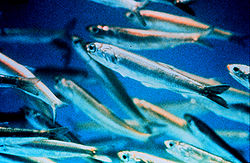 |
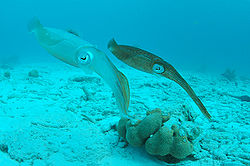 |
 |
| Anchovies | Caribbean reef squid | Menhaden |
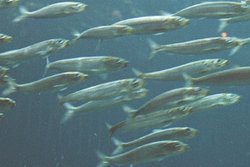 |
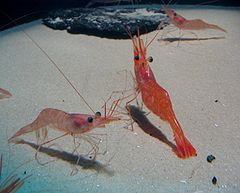 |
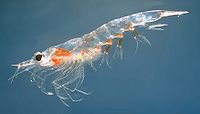 |
| Sardines | Shrimp | Northern krill |
Forage fish utilise the biomass of copepod
Copepod
Copepods are a group of small crustaceans found in the sea and nearly every freshwater habitat. Some species are planktonic , some are benthic , and some continental species may live in limno-terrestrial habitats and other wet terrestrial places, such as swamps, under leaf fall in wet forests,...
s, mysids and krill
Krill
Krill is the common name given to the order Euphausiacea of shrimp-like marine crustaceans. Also known as euphausiids, these small invertebrates are found in all oceans of the world...
in the pelagic zone
Pelagic zone
Any water in a sea or lake that is not close to the bottom or near to the shore can be said to be in the pelagic zone. The word pelagic comes from the Greek πέλαγος or pélagos, which means "open sea". The pelagic zone can be thought of in terms of an imaginary cylinder or water column that goes...
to become the dominant converters of the enormous ocean production of zooplankton
Zooplankton
Zooplankton are heterotrophic plankton. Plankton are organisms drifting in oceans, seas, and bodies of fresh water. The word "zooplankton" is derived from the Greek zoon , meaning "animal", and , meaning "wanderer" or "drifter"...
. They are, in turn, central prey items for higher trophic level
Trophic level
The trophic level of an organism is the position it occupies in a food chain. The word trophic derives from the Greek τροφή referring to food or feeding. A food chain represents a succession of organisms that eat another organism and are, in turn, eaten themselves. The number of steps an organism...
s. Forage fish may have achieved their dominance because of the way they live in huge, and often extremely fast cruising schools.
Though forage fish are abundant, there are relatively few species. There are more species of primary producers and apex predators in the ocean than there are forage fish.
Ocean food webs
Forage fish occupy central positions in the ocean food webFood web
A food web depicts feeding connections in an ecological community. Ecologists can broadly lump all life forms into one of two categories called trophic levels: 1) the autotrophs, and 2) the heterotrophs...
s. The position that a fish occupies in a food web is called its trophic level
Trophic level
The trophic level of an organism is the position it occupies in a food chain. The word trophic derives from the Greek τροφή referring to food or feeding. A food chain represents a succession of organisms that eat another organism and are, in turn, eaten themselves. The number of steps an organism...
(Greek
Greek language
Greek is an independent branch of the Indo-European family of languages. Native to the southern Balkans, it has the longest documented history of any Indo-European language, spanning 34 centuries of written records. Its writing system has been the Greek alphabet for the majority of its history;...
trophē = food). The organisms it eats are at a lower trophic level, and the organisms that eat it are at a higher trophic level. Forage fish occupy middle levels in the food web, serving as a dominant prey to higher level fish, seabirds and mammals.
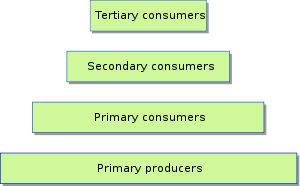
Ecological pyramid
thumb|300px|right|An ecological pyramid.An ecological pyramid is a graphical representation designed to show the biomass or biomass productivity at each trophic level in a given ecosystem....
s are graphical representations, along the lines of the diagram at the right, which show how biomass
Biomass (ecology)
Biomass, in ecology, is the mass of living biological organisms in a given area or ecosystem at a given time. Biomass can refer to species biomass, which is the mass of one or more species, or to community biomass, which is the mass of all species in the community. It can include microorganisms,...
or productivity
Primary production
400px|thumb|Global oceanic and terrestrial photoautotroph abundance, from September [[1997]] to August 2000. As an estimate of autotroph biomass, it is only a rough indicator of primary production potential, and not an actual estimate of it...
changes at each trophic level in a ecosystem
Ecosystem
An ecosystem is a biological environment consisting of all the organisms living in a particular area, as well as all the nonliving , physical components of the environment with which the organisms interact, such as air, soil, water and sunlight....
. The first or bottom level is occupied by primary producers
Primary production
400px|thumb|Global oceanic and terrestrial photoautotroph abundance, from September [[1997]] to August 2000. As an estimate of autotroph biomass, it is only a rough indicator of primary production potential, and not an actual estimate of it...
or autotroph
Autotroph
An autotroph, or producer, is an organism that produces complex organic compounds from simple inorganic molecules using energy from light or inorganic chemical reactions . They are the producers in a food chain, such as plants on land or algae in water...
s (Greek
Greek language
Greek is an independent branch of the Indo-European family of languages. Native to the southern Balkans, it has the longest documented history of any Indo-European language, spanning 34 centuries of written records. Its writing system has been the Greek alphabet for the majority of its history;...
autos = self and trophe = food). These are the names given to organisms that do not feed on other organisms, but produce biomass from inorganic compounds, mostly by a process
Biological process
A biological process is a process of a living organism. Biological processes are made up of any number of chemical reactions or other events that results in a transformation....
of photosynthesis
Photosynthesis
Photosynthesis is a chemical process that converts carbon dioxide into organic compounds, especially sugars, using the energy from sunlight. Photosynthesis occurs in plants, algae, and many species of bacteria, but not in archaea. Photosynthetic organisms are called photoautotrophs, since they can...
.
In oceans, most primary production is performed by algae
Algae
Algae are a large and diverse group of simple, typically autotrophic organisms, ranging from unicellular to multicellular forms, such as the giant kelps that grow to 65 meters in length. They are photosynthetic like plants, and "simple" because their tissues are not organized into the many...
. This is a contrast to land, where most primary production is performed by vascular plants. Algae ranges from single floating cells to attached seaweeds, while vascular plants are represented in the ocean by groups such as the seagrass
Seagrass
Seagrasses are flowering plants from one of four plant families , all in the order Alismatales , which grow in marine, fully saline environments.-Ecology:...
es. Larger producers, such as seagrasses and seaweeds, are mostly confined to the littoral
Littoral
The littoral zone is that part of a sea, lake or river that is close to the shore. In coastal environments the littoral zone extends from the high water mark, which is rarely inundated, to shoreline areas that are permanently submerged. It always includes this intertidal zone and is often used to...
zone and shallow waters, where they attach
Holdfast
A holdfast is a root-like structure that anchors aquatic sessile organisms, such as seaweed, other sessile algae, stalked crinoids, benthic cnidarians, and sponges, to the substrate. ...
to the underlying substrate and still be within the photic zone
Photic zone
The photic zone or euphotic zone is the depth of the water in a lake or ocean that is exposed to sufficient sunlight for photosynthesis to occur...
. Most primary production in the ocean is performed by microscopic organisms
Microorganism
A microorganism or microbe is a microscopic organism that comprises either a single cell , cell clusters, or no cell at all...
, the phytoplankton
Phytoplankton
Phytoplankton are the autotrophic component of the plankton community. The name comes from the Greek words φυτόν , meaning "plant", and πλαγκτός , meaning "wanderer" or "drifter". Most phytoplankton are too small to be individually seen with the unaided eye...
.
Thus, in ocean environments, the first bottom trophic level is occupied principally by phytoplankton
Phytoplankton
Phytoplankton are the autotrophic component of the plankton community. The name comes from the Greek words φυτόν , meaning "plant", and πλαγκτός , meaning "wanderer" or "drifter". Most phytoplankton are too small to be individually seen with the unaided eye...
, microscopic drifting organisms, mostly one-celled algae
Algae
Algae are a large and diverse group of simple, typically autotrophic organisms, ranging from unicellular to multicellular forms, such as the giant kelps that grow to 65 meters in length. They are photosynthetic like plants, and "simple" because their tissues are not organized into the many...
, that float in the sea. Most phytoplankton are too small to be seen individually with the unaided eye
Naked eye
The naked eye is a figure of speech referring to human visual perception unaided by a magnifying or light-collecting optical device, such as a telescope or microscope. Vision corrected to normal acuity using corrective lenses is considered "naked"...
. They can appear as a green discoloration of the water when they are present in high enough numbers. Since they increase their biomass mostly through photosynthesis they live in the sun-lit surface layer (euphotic zone
Photic zone
The photic zone or euphotic zone is the depth of the water in a lake or ocean that is exposed to sufficient sunlight for photosynthesis to occur...
) of the sea.
 |
 |
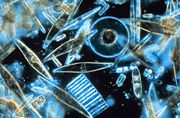 |
| Phytoplankton | Dinoflagellate | Diatoms |
The most important groups of phytoplankton include the diatom
Diatom
Diatoms are a major group of algae, and are one of the most common types of phytoplankton. Most diatoms are unicellular, although they can exist as colonies in the shape of filaments or ribbons , fans , zigzags , or stellate colonies . Diatoms are producers within the food chain...
s and dinoflagellate
Dinoflagellate
The dinoflagellates are a large group of flagellate protists. Most are marine plankton, but they are common in fresh water habitats as well. Their populations are distributed depending on temperature, salinity, or depth...
s. Diatoms are especially important in oceans, where they are estimated to contribute up to 45% of the total ocean's primary production. Diatoms are usually microscopic
Microscope
A microscope is an instrument used to see objects that are too small for the naked eye. The science of investigating small objects using such an instrument is called microscopy...
, although some species can reach up to 2 millimetres in length.
The second trophic level (primary consumers) is occupied by zooplankton
Zooplankton
Zooplankton are heterotrophic plankton. Plankton are organisms drifting in oceans, seas, and bodies of fresh water. The word "zooplankton" is derived from the Greek zoon , meaning "animal", and , meaning "wanderer" or "drifter"...
which feed off the phytoplankton. Together with the phytoplankton, they form the base of the food pyramid that supports most of the world's great fishing grounds. Zooplankton are tiny animals found with the phytoplankton in ocean
Ocean
An ocean is a major body of saline water, and a principal component of the hydrosphere. Approximately 71% of the Earth's surface is covered by ocean, a continuous body of water that is customarily divided into several principal oceans and smaller seas.More than half of this area is over 3,000...
ic surface waters
Photic zone
The photic zone or euphotic zone is the depth of the water in a lake or ocean that is exposed to sufficient sunlight for photosynthesis to occur...
, and include tiny crustacean
Crustacean
Crustaceans form a very large group of arthropods, usually treated as a subphylum, which includes such familiar animals as crabs, lobsters, crayfish, shrimp, krill and barnacles. The 50,000 described species range in size from Stygotantulus stocki at , to the Japanese spider crab with a leg span...
s, and fish larvae and fry (recently-hatched fish). Most zooplankton are filter feeder
Filter feeder
Filter feeders are animals that feed by straining suspended matter and food particles from water, typically by passing the water over a specialized filtering structure. Some animals that use this method of feeding are clams, krill, sponges, baleen whales, and many fish and some sharks. Some birds,...
s, and they use appendages to strain the phytoplankton in the water. Some larger zooplankton also feed on smaller zooplankton. Some zooplankton can jump about a bit to avoid predators, but they can't really swim. Like phytoplankton, they float with the currents, tides and winds instead. Zooplanktons can reproduce rapidly, their populations can increase up to thirty percent a day under favourable conditions. Many live short and productive lives and reach maturity quickly.
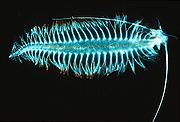 |
 |
 |
| Segmented worm | Tiny shrimp-like crustaceans | Juvenile planktonic squid |
Particularly important groups of zooplankton are the copepod
Copepod
Copepods are a group of small crustaceans found in the sea and nearly every freshwater habitat. Some species are planktonic , some are benthic , and some continental species may live in limno-terrestrial habitats and other wet terrestrial places, such as swamps, under leaf fall in wet forests,...
s and krill
Krill
Krill is the common name given to the order Euphausiacea of shrimp-like marine crustaceans. Also known as euphausiids, these small invertebrates are found in all oceans of the world...
. These are not shown in the images above, but are discussed in more detail later. Copepod
Copepod
Copepods are a group of small crustaceans found in the sea and nearly every freshwater habitat. Some species are planktonic , some are benthic , and some continental species may live in limno-terrestrial habitats and other wet terrestrial places, such as swamps, under leaf fall in wet forests,...
s are a group of small crustacean
Crustacean
Crustaceans form a very large group of arthropods, usually treated as a subphylum, which includes such familiar animals as crabs, lobsters, crayfish, shrimp, krill and barnacles. The 50,000 described species range in size from Stygotantulus stocki at , to the Japanese spider crab with a leg span...
s found in ocean and freshwater
Fresh Water
Fresh Water is the debut album by Australian rock and blues singer Alison McCallum, released in 1972. Rare for an Australian artist at the time, it came in a gatefold sleeve...
habitats
Habitat (ecology)
A habitat is an ecological or environmental area that is inhabited by a particular species of animal, plant or other type of organism...
. They are the biggest source of protein in the sea, and are important prey for forage fish. Krill
Krill
Krill is the common name given to the order Euphausiacea of shrimp-like marine crustaceans. Also known as euphausiids, these small invertebrates are found in all oceans of the world...
constitute the next biggest source of protein. Krill are particularly large predator zooplankton which feed on smaller zooplankton. This means they really belong to the third trophic level, secondary consumers, along with the forage fish.
Together, phytoplankton and zooplankton make up most of the plankton
Plankton
Plankton are any drifting organisms that inhabit the pelagic zone of oceans, seas, or bodies of fresh water. That is, plankton are defined by their ecological niche rather than phylogenetic or taxonomic classification...
in the sea. Plankton is the term applied to any small drifting organism
Organism
In biology, an organism is any contiguous living system . In at least some form, all organisms are capable of response to stimuli, reproduction, growth and development, and maintenance of homoeostasis as a stable whole.An organism may either be unicellular or, as in the case of humans, comprise...
s that float in the sea (Greek
Greek language
Greek is an independent branch of the Indo-European family of languages. Native to the southern Balkans, it has the longest documented history of any Indo-European language, spanning 34 centuries of written records. Its writing system has been the Greek alphabet for the majority of its history;...
planktos = wanderer or drifter). By definition, organisms classified as plankton are unable to swim against ocean currents; they cannot resist the ambient current and control their position. In ocean environments, the first two tropic levels are occupied mainly by plankton
Plankton
Plankton are any drifting organisms that inhabit the pelagic zone of oceans, seas, or bodies of fresh water. That is, plankton are defined by their ecological niche rather than phylogenetic or taxonomic classification...
. Plankton are divided into producers and consumers. The producers are the phytoplankton
Phytoplankton
Phytoplankton are the autotrophic component of the plankton community. The name comes from the Greek words φυτόν , meaning "plant", and πλαγκτός , meaning "wanderer" or "drifter". Most phytoplankton are too small to be individually seen with the unaided eye...
(Greek phyton = plant) and the consumers, who eat the phytoplankton, are the zooplankton
Zooplankton
Zooplankton are heterotrophic plankton. Plankton are organisms drifting in oceans, seas, and bodies of fresh water. The word "zooplankton" is derived from the Greek zoon , meaning "animal", and , meaning "wanderer" or "drifter"...
(Greek zoon = animal).
Diet
Forage fish feed on planktonPlankton
Plankton are any drifting organisms that inhabit the pelagic zone of oceans, seas, or bodies of fresh water. That is, plankton are defined by their ecological niche rather than phylogenetic or taxonomic classification...
. When they are eaten by larger predators, they transfer this energy from the bottom of the food chain to the top and in this way are the central link between trophic level
Trophic level
The trophic level of an organism is the position it occupies in a food chain. The word trophic derives from the Greek τροφή referring to food or feeding. A food chain represents a succession of organisms that eat another organism and are, in turn, eaten themselves. The number of steps an organism...
s.
Forage fish are usually filter feeder
Filter feeder
Filter feeders are animals that feed by straining suspended matter and food particles from water, typically by passing the water over a specialized filtering structure. Some animals that use this method of feeding are clams, krill, sponges, baleen whales, and many fish and some sharks. Some birds,...
s, meaning that they feed by straining suspended matter and food particles from water. They usually travel in large, slow moving, tightly packed schools
Swarm
Swarm behaviour, or swarming, is a collective behaviour exhibited by animals of similar size which aggregate together, perhaps milling about the same spot or perhaps moving en masse or migrating in some direction. As a term, swarming is applied particularly to insects, but can also be applied to...
with their mouths open. They are typically omnivorous. Their diet is usually based primarily on zooplankton, although, since they are omnivorous, they also take in some phytoplankton.
Young forage fish, such as herring, mostly feed on phytoplankton
Phytoplankton
Phytoplankton are the autotrophic component of the plankton community. The name comes from the Greek words φυτόν , meaning "plant", and πλαγκτός , meaning "wanderer" or "drifter". Most phytoplankton are too small to be individually seen with the unaided eye...
and as they mature they start to consume larger organisms. Older herrings feed on zooplankton
Zooplankton
Zooplankton are heterotrophic plankton. Plankton are organisms drifting in oceans, seas, and bodies of fresh water. The word "zooplankton" is derived from the Greek zoon , meaning "animal", and , meaning "wanderer" or "drifter"...
, tiny animals that are found in ocean
Ocean
An ocean is a major body of saline water, and a principal component of the hydrosphere. Approximately 71% of the Earth's surface is covered by ocean, a continuous body of water that is customarily divided into several principal oceans and smaller seas.More than half of this area is over 3,000...
ic surface waters
Photic zone
The photic zone or euphotic zone is the depth of the water in a lake or ocean that is exposed to sufficient sunlight for photosynthesis to occur...
, and fish larvae and fry (recently-hatched fish). Copepod
Copepod
Copepods are a group of small crustaceans found in the sea and nearly every freshwater habitat. Some species are planktonic , some are benthic , and some continental species may live in limno-terrestrial habitats and other wet terrestrial places, such as swamps, under leaf fall in wet forests,...
s and other tiny crustacean
Crustacean
Crustaceans form a very large group of arthropods, usually treated as a subphylum, which includes such familiar animals as crabs, lobsters, crayfish, shrimp, krill and barnacles. The 50,000 described species range in size from Stygotantulus stocki at , to the Japanese spider crab with a leg span...
s are common zooplankton eaten by forage fish. During daylight
Daylight
Daylight or the light of day is the combination of all direct and indirect sunlight outdoors during the daytime. This includes direct sunlight, diffuse sky radiation, and both of these reflected from the Earth and terrestrial objects. Sunlight scattered or reflected from objects in outer space is...
, many forage fish stay in the safety of deep water, feeding at the surface only at night when there is less chance of predation. They swim with their mouths open, filtering plankton
Plankton
Plankton are any drifting organisms that inhabit the pelagic zone of oceans, seas, or bodies of fresh water. That is, plankton are defined by their ecological niche rather than phylogenetic or taxonomic classification...
from the water as it passes through their gills.
Ocean halfbeak
Halfbeak
The halfbeaks are a geographically widespread and numerically abundant family of epipelagic fish inhabiting warm waters around the world. The family Hemiramphidae is divided into two subfamilies, the primarily marine Hemiramphinae and the freshwater or estuarine Zenarchopterinae...
s are omnivore
Omnivore
Omnivores are species that eat both plants and animals as their primary food source...
s which feed on algae
Algae
Algae are a large and diverse group of simple, typically autotrophic organisms, ranging from unicellular to multicellular forms, such as the giant kelps that grow to 65 meters in length. They are photosynthetic like plants, and "simple" because their tissues are not organized into the many...
, plankton
Plankton
Plankton are any drifting organisms that inhabit the pelagic zone of oceans, seas, or bodies of fresh water. That is, plankton are defined by their ecological niche rather than phylogenetic or taxonomic classification...
, marine plants like seagrass
Seagrass
Seagrasses are flowering plants from one of four plant families , all in the order Alismatales , which grow in marine, fully saline environments.-Ecology:...
, invertebrates like pteropods
Sea butterfly
Sea butterflies, also known as Thecosomata or flapping snails, are a taxonomic suborder of small pelagic swimming sea snails. These are holoplanktonic opisthobranch gastropod mollusks in the informal group Opisthobranchia. They include some of the world's most abundant gastropod species.This group...
and crustaceans and smaller fishes. Some tropical species feed on animals during the day and plants at night, while others alternate summer carnivory with winter herbivory. They are in turn eaten by billfish
Billfish
The term billfish is applied to a number of different large, predatory fish characterised by their large size and their long, sword-like bill. Billfish include the sailfish and marlin, which make up the family Istiophoridae, and the swordfish, sole member of the family Xiphiidae...
, mackerel
Mackerel
Mackerel is a common name applied to a number of different species of fish, mostly, but not exclusively, from the family Scombridae. They may be found in all tropical and temperate seas. Most live offshore in the oceanic environment but a few, like the Spanish mackerel , enter bays and can be...
, and shark
Shark
Sharks are a type of fish with a full cartilaginous skeleton and a highly streamlined body. The earliest known sharks date from more than 420 million years ago....
s.
Predators
Forage fish are the food that sustains larger predators above them in the ocean food chain. The superabundance they present in their schools make them ideal food sources for top predator fish such as tunaTuna
Tuna is a salt water fish from the family Scombridae, mostly in the genus Thunnus. Tuna are fast swimmers, and some species are capable of speeds of . Unlike most fish, which have white flesh, the muscle tissue of tuna ranges from pink to dark red. The red coloration derives from myoglobin, an...
, striped bass
Striped bass
The striped bass is the state fish of Maryland, Rhode Island, South Carolina, and the state saltwater fish of New York, Virginia, and New Hampshire...
, cod
Cod
Cod is the common name for genus Gadus, belonging to the family Gadidae, and is also used in the common name for various other fishes. Cod is a popular food with a mild flavor, low fat content and a dense, flaky white flesh. Cod livers are processed to make cod liver oil, an important source of...
, salmon
Salmon
Salmon is the common name for several species of fish in the family Salmonidae. Several other fish in the same family are called trout; the difference is often said to be that salmon migrate and trout are resident, but this distinction does not strictly hold true...
, barracuda
Barracuda
The barracuda is a ray-finned fish known for its large size and fearsome appearance. Its body is long, fairly compressed, and covered with small, smooth scales. Some species could reach up to 1.8m in length and 30 cm in width...
and swordfish
Swordfish
Swordfish , also known as broadbill in some countries, are large, highly migratory, predatory fish characterized by a long, flat bill. They are a popular sport fish of the billfish category, though elusive. Swordfish are elongated, round-bodied, and lose all teeth and scales by adulthood...
, as well as shark
Shark
Sharks are a type of fish with a full cartilaginous skeleton and a highly streamlined body. The earliest known sharks date from more than 420 million years ago....
s, whale
Whale
Whale is the common name for various marine mammals of the order Cetacea. The term whale sometimes refers to all cetaceans, but more often it excludes dolphins and porpoises, which belong to suborder Odontoceti . This suborder also includes the sperm whale, killer whale, pilot whale, and beluga...
s, dolphin
Dolphin
Dolphins are marine mammals that are closely related to whales and porpoises. There are almost forty species of dolphin in 17 genera. They vary in size from and , up to and . They are found worldwide, mostly in the shallower seas of the continental shelves, and are carnivores, mostly eating...
s, porpoise
Porpoise
Porpoises are small cetaceans of the family Phocoenidae; they are related to whales and dolphins. They are distinct from dolphins, although the word "porpoise" has been used to refer to any small dolphin, especially by sailors and fishermen...
s, seal
Earless seal
The true seals or earless seals are one of the three main groups of mammals within the seal superfamily, Pinnipedia. All true seals are members of the family Phocidae . They are sometimes called crawling seals to distinguish them from the fur seals and sea lions of the family Otariidae...
s, sea lion
Sea Lion
Sea lions are pinnipeds characterized by external ear-flaps, long fore-flippers, the ability to walk on all fours, and short thick hair. Together with the fur seal, they comprise the family Otariidae, or eared seals. There are six extant and one extinct species in five genera...
s, and seabird
Seabird
Seabirds are birds that have adapted to life within the marine environment. While seabirds vary greatly in lifestyle, behaviour and physiology, they often exhibit striking convergent evolution, as the same environmental problems and feeding niches have resulted in similar adaptations...
s.
 |
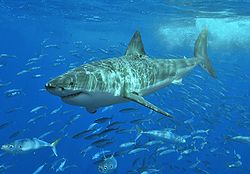 |
 |
| Tuna | Shark | Striped bass |
 |
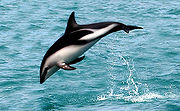 |
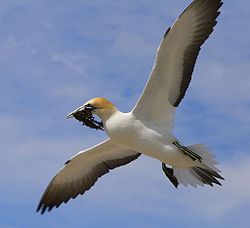 |
| Leopard seal | Dolphin | Gannet |
Schooling

Swarm
Swarm behaviour, or swarming, is a collective behaviour exhibited by animals of similar size which aggregate together, perhaps milling about the same spot or perhaps moving en masse or migrating in some direction. As a term, swarming is applied particularly to insects, but can also be applied to...
. These sometimes immense gatherings fuel the ocean food web. Most forage fish are pelagic fish
Pelagic fish
Pelagic fish live near the surface or in the water column of coastal, ocean and lake waters, but not on the bottom of the sea or the lake. They can be contrasted with demersal fish, which do live on or near the bottom, and reef fish which are associated with coral reefs.The marine pelagic...
, which means they form their schools in open water, and not on the bottom (benthic fish) or near the bottom (benthopelagic fish). They are short-lived, and go mostly unnoticed by humans, apart from an occasional support role in a documentary about a great ocean predator. While we may not pay them much attention, the great marine predators are keenly focused on them, acutely aware of their numbers and whereabouts, and make migrations
Fish migration
Many types of fish migrate on a regular basis, on time scales ranging from daily to annually or longer, and over distances ranging from a few metres to thousands of kilometres...
that can span thousands of miles to connect with them. After all, forage fish are their food.
Herring
Herring
Herring is an oily fish of the genus Clupea, found in the shallow, temperate waters of the North Pacific and the North Atlantic oceans, including the Baltic Sea. Three species of Clupea are recognized. The main taxa, the Atlantic herring and the Pacific herring may each be divided into subspecies...
are among the most spectacular schooling fish. They aggregate together in huge numbers. Schools have been measured at over four cubic kilometres in size, containing about four billion fish. These schools move along coastlines and traverse the open oceans. Herring schools in general have very precise arrangements which allow the school to maintain relatively constant cruising speeds. Herrings have excellent hearing, and their schools react very fast to a predator. The herrings keep a certain distance from a moving scuba diver or cruising predator like a killer whale, forming a vacuole which can look like a doughnut from a spotter plane. The intricacies of schooling is far from fully understood, especially the swimming and feeding energetics. Many hypotheses to explain the function of schooling have been suggested, such as better orientation, synchronized
Synchronization
Synchronization is timekeeping which requires the coordination of events to operate a system in unison. The familiar conductor of an orchestra serves to keep the orchestra in time....
hunting, predator confusion and reduced risk of being found. Schooling also has disadvantages, such as excretion buildup in the breathing media and oxygen and food depletion. The way the fish array in the school probably gives energy saving advantages, though this is controversial.
On calm days, schools of herring can be detected at the surface a mile away by little waves they form, or from several meters at night when they trigger bioluminescence
Bioluminescence
Bioluminescence is the production and emission of light by a living organism. Its name is a hybrid word, originating from the Greek bios for "living" and the Latin lumen "light". Bioluminescence is a naturally occurring form of chemiluminescence where energy is released by a chemical reaction in...
in surrounding plankton
Plankton
Plankton are any drifting organisms that inhabit the pelagic zone of oceans, seas, or bodies of fresh water. That is, plankton are defined by their ecological niche rather than phylogenetic or taxonomic classification...
. Underwater recordings show herring constantly cruising at high speeds up to 108 cm per second, with much higher escape speeds.
They are fragile fish, and because of their adaptation to schooling behaviour they are rarely displayed in aquaria
Aquaria
Aquaria may refer to:*Aquarium, in the plural*Aquaria , a computer game*Aquaria , a Brazilian metal band*Aquaria, one of the Twelve Colonies in Battlestar Galactica...
. Even with the best facilities aquaria can offer they become sluggish compared to their quivering energy in wild schools.


Hunting copepods
CopepodCopepod
Copepods are a group of small crustaceans found in the sea and nearly every freshwater habitat. Some species are planktonic , some are benthic , and some continental species may live in limno-terrestrial habitats and other wet terrestrial places, such as swamps, under leaf fall in wet forests,...
s are a group of small crustacean
Crustacean
Crustaceans form a very large group of arthropods, usually treated as a subphylum, which includes such familiar animals as crabs, lobsters, crayfish, shrimp, krill and barnacles. The 50,000 described species range in size from Stygotantulus stocki at , to the Japanese spider crab with a leg span...
s found in ocean and freshwater
Fresh Water
Fresh Water is the debut album by Australian rock and blues singer Alison McCallum, released in 1972. Rare for an Australian artist at the time, it came in a gatefold sleeve...
habitats
Habitat (ecology)
A habitat is an ecological or environmental area that is inhabited by a particular species of animal, plant or other type of organism...
. Many species are plankton
Plankton
Plankton are any drifting organisms that inhabit the pelagic zone of oceans, seas, or bodies of fresh water. That is, plankton are defined by their ecological niche rather than phylogenetic or taxonomic classification...
ic (drifting in the ocean water), while others are benthic
Benthos
Benthos is the community of organisms which live on, in, or near the seabed, also known as the benthic zone. This community lives in or near marine sedimentary environments, from tidal pools along the foreshore, out to the continental shelf, and then down to the abyssal depths.Many organisms...
(living on the sea floor). Copepods are typically one millimetre (0.04 in) to two millimetres (0.08 in) long, with a teardrop shaped body. Like other crustacean
Crustacean
Crustaceans form a very large group of arthropods, usually treated as a subphylum, which includes such familiar animals as crabs, lobsters, crayfish, shrimp, krill and barnacles. The 50,000 described species range in size from Stygotantulus stocki at , to the Japanese spider crab with a leg span...
s they have an armoured exoskeleton
Exoskeleton
An exoskeleton is the external skeleton that supports and protects an animal's body, in contrast to the internal skeleton of, for example, a human. In popular usage, some of the larger kinds of exoskeletons are known as "shells". Examples of exoskeleton animals include insects such as grasshoppers...
, but they are so small that this armour, and the entire body, is usually transparent.
Copepods are usually the dominant zooplankton
Zooplankton
Zooplankton are heterotrophic plankton. Plankton are organisms drifting in oceans, seas, and bodies of fresh water. The word "zooplankton" is derived from the Greek zoon , meaning "animal", and , meaning "wanderer" or "drifter"...
. Some scientists say they form the largest animal biomass
Biomass
Biomass, as a renewable energy source, is biological material from living, or recently living organisms. As an energy source, biomass can either be used directly, or converted into other energy products such as biofuel....
on the planet. The other contender is the Antarctic krill
Antarctic krill
Antarctic krill, Euphausia superba, is a species of krill found in the Antarctic waters of the Southern Ocean. It is a shrimp-like crustacean that lives in large schools, called swarms, sometimes reaching densities of 10,000–30,000 individual animals per cubic metre...
. But copepods are smaller than krill, with faster growth rates, and they are more evenly distributed throughout the oceans. This means copepods almost certainly contribute more secondary production to the world's oceans than krill, and perhaps more than all other groups of marine organisms together. They are a major item on the forage fish menu.
Copepods are very alert and evasive. They have large antennae
Antenna (biology)
Antennae in biology have historically been paired appendages used for sensing in arthropods. More recently, the term has also been applied to cilium structures present in most cell types of eukaryotes....
. When they spread their antennae they can sense the pressure wave from an approaching fish and jump with great speed over a few centimeters.
Herrings are pelagic feeders. Their prey consists of a wide spectrum of phytoplankton and zooplankton, amongst which copepods are the dominant prey. Young herring
Herring
Herring is an oily fish of the genus Clupea, found in the shallow, temperate waters of the North Pacific and the North Atlantic oceans, including the Baltic Sea. Three species of Clupea are recognized. The main taxa, the Atlantic herring and the Pacific herring may each be divided into subspecies...
usually capture small copepods by hunting them individually— they approach them from below. The (half speed) video loop at the left shows a juvenile herring feeding on copepod
Copepod
Copepods are a group of small crustaceans found in the sea and nearly every freshwater habitat. Some species are planktonic , some are benthic , and some continental species may live in limno-terrestrial habitats and other wet terrestrial places, such as swamps, under leaf fall in wet forests,...
s. In the middle of the image a copepod escapes successfully to the left. The opercula
Operculum (fish)
The operculum of a bony fish is the hard bony flap covering and protecting the gills. In most fish, the rear edge of the operculum roughly marks the division between the head and the body....
(hard bony flaps covering the gill
Gill
A gill is a respiratory organ found in many aquatic organisms that extracts dissolved oxygen from water, afterward excreting carbon dioxide. The gills of some species such as hermit crabs have adapted to allow respiration on land provided they are kept moist...
s) are spread wide open to compensate the pressure wave which would alert the copepod to trigger a jump.


Gill raker
Gill rakers in fish are bony or cartilaginous processes that project from the branchial arch and are involved with filter feeding tiny prey. They are not to be confused with the gill filaments that compose the bony part of the gill. Rakers are usually present in two rows, projecting from both the...
s for a few milliseconds (filter feeding). In the photo on the right, herring ram feed on a school of copepod
Copepod
Copepods are a group of small crustaceans found in the sea and nearly every freshwater habitat. Some species are planktonic , some are benthic , and some continental species may live in limno-terrestrial habitats and other wet terrestrial places, such as swamps, under leaf fall in wet forests,...
s. The fish all open their mouths and opercula wide at the same time (the red gills are visible—click to enlarge). The fish swim in a grid where the distance between them is the same as the jump length of their prey, as indicated in the animation below.
In the animation, juvenile herring hunt the copepod
Copepod
Copepods are a group of small crustaceans found in the sea and nearly every freshwater habitat. Some species are planktonic , some are benthic , and some continental species may live in limno-terrestrial habitats and other wet terrestrial places, such as swamps, under leaf fall in wet forests,...
s in synchronization: The copepods sense with their antennae
Antenna (biology)
Antennae in biology have historically been paired appendages used for sensing in arthropods. More recently, the term has also been applied to cilium structures present in most cell types of eukaryotes....
the pressure-wave of an approaching herring and react with a fast escape jump. The length of the jump is fairly constant. The fish align themselves in a grid with this characteristic jump length. A copepod can dart about 80 times before it tires out. After a jump, it takes it 60 milliseconds to spread its antennae again, and this time delay becomes its undoing, as the almost endless stream of herrings allows a herring to eventually snap the copepod. A single juvenile herring could never catch a large copepod.
Migrations
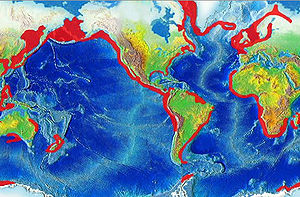
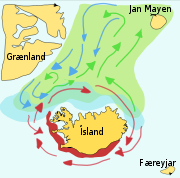
Forage fish often make great migrations
Fish migration
Many types of fish migrate on a regular basis, on time scales ranging from daily to annually or longer, and over distances ranging from a few metres to thousands of kilometres...
between their spawning, feeding and nursery grounds. Schools of a particular stock usually travel in a triangle between these grounds. For example, one stock of herrings have their spawning ground in southern Norway
Norway
Norway , officially the Kingdom of Norway, is a Nordic unitary constitutional monarchy whose territory comprises the western portion of the Scandinavian Peninsula, Jan Mayen, and the Arctic archipelago of Svalbard and Bouvet Island. Norway has a total area of and a population of about 4.9 million...
, their feeding ground in Iceland
Iceland
Iceland , described as the Republic of Iceland, is a Nordic and European island country in the North Atlantic Ocean, on the Mid-Atlantic Ridge. Iceland also refers to the main island of the country, which contains almost all the population and almost all the land area. The country has a population...
, and their nursery ground in northern Norway. Wide triangular journeys such as these may be important because forage fish, when feeding, cannot distinguish their own offspring.
Fertile feeding grounds for forage fish are provided by ocean upwellings. Oceanic gyres are large-scale ocean currents caused by the Coriolis effect
Coriolis effect
In physics, the Coriolis effect is a deflection of moving objects when they are viewed in a rotating reference frame. In a reference frame with clockwise rotation, the deflection is to the left of the motion of the object; in one with counter-clockwise rotation, the deflection is to the right...
. Wind-driven surface currents interact with these gyres and the underwater topography, such as seamount
Seamount
A seamount is a mountain rising from the ocean seafloor that does not reach to the water's surface , and thus is not an island. These are typically formed from extinct volcanoes, that rise abruptly and are usually found rising from a seafloor of depth. They are defined by oceanographers as...
s and the edge of continental shelves
Continental shelf
The continental shelf is the extended perimeter of each continent and associated coastal plain. Much of the shelf was exposed during glacial periods, but is now submerged under relatively shallow seas and gulfs, and was similarly submerged during other interglacial periods. The continental margin,...
, to produce downwellings and upwelling
Upwelling
Upwelling is an oceanographic phenomenon that involves wind-driven motion of dense, cooler, and usually nutrient-rich water towards the ocean surface, replacing the warmer, usually nutrient-depleted surface water. The increased availability in upwelling regions results in high levels of primary...
s. These can transport nutrients which plankton thrive on. The result can be rich feeding grounds attractive to the plankton feeding forage fish. In turn, the forage fish themselves become a feeding ground for larger predator fish. Most upwellings are coastal, and many of them support some of the most productive fisheries in the world. Regions of notable upwelling include coastal Peru
Peru
Peru , officially the Republic of Peru , is a country in western South America. It is bordered on the north by Ecuador and Colombia, on the east by Brazil, on the southeast by Bolivia, on the south by Chile, and on the west by the Pacific Ocean....
, Chile
Chile
Chile ,officially the Republic of Chile , is a country in South America occupying a long, narrow coastal strip between the Andes mountains to the east and the Pacific Ocean to the west. It borders Peru to the north, Bolivia to the northeast, Argentina to the east, and the Drake Passage in the far...
, Arabian Sea
Arabian Sea
The Arabian Sea is a region of the Indian Ocean bounded on the east by India, on the north by Pakistan and Iran, on the west by the Arabian Peninsula, on the south, approximately, by a line between Cape Guardafui in northeastern Somalia and Kanyakumari in India...
, western South Africa
South Africa
The Republic of South Africa is a country in southern Africa. Located at the southern tip of Africa, it is divided into nine provinces, with of coastline on the Atlantic and Indian oceans...
, eastern New Zealand
New Zealand
New Zealand is an island country in the south-western Pacific Ocean comprising two main landmasses and numerous smaller islands. The country is situated some east of Australia across the Tasman Sea, and roughly south of the Pacific island nations of New Caledonia, Fiji, and Tonga...
and the California
California
California is a state located on the West Coast of the United States. It is by far the most populous U.S. state, and the third-largest by land area...
coast.
Capelin
Capelin
The capelin or caplin, Mallotus villosus, is a small forage fish of the smelt family found in the Atlantic and Arctic oceans. In summer, it grazes on dense swarms of plankton at the edge of the ice shelf. Larger capelin also eat a great deal of krill and other crustaceans...
are a forage fish of the smelt family found in the Atlantic
Atlantic Ocean
The Atlantic Ocean is the second-largest of the world's oceanic divisions. With a total area of about , it covers approximately 20% of the Earth's surface and about 26% of its water surface area...
and Arctic
Arctic Ocean
The Arctic Ocean, located in the Northern Hemisphere and mostly in the Arctic north polar region, is the smallest and shallowest of the world's five major oceanic divisions...
oceans. In summer, they graze on dense swarms of plankton
Plankton
Plankton are any drifting organisms that inhabit the pelagic zone of oceans, seas, or bodies of fresh water. That is, plankton are defined by their ecological niche rather than phylogenetic or taxonomic classification...
at the edge of the ice shelf. Larger capelin also eat krill
Krill
Krill is the common name given to the order Euphausiacea of shrimp-like marine crustaceans. Also known as euphausiids, these small invertebrates are found in all oceans of the world...
and other crustacean
Crustacean
Crustaceans form a very large group of arthropods, usually treated as a subphylum, which includes such familiar animals as crabs, lobsters, crayfish, shrimp, krill and barnacles. The 50,000 described species range in size from Stygotantulus stocki at , to the Japanese spider crab with a leg span...
s. The capelin move inshore in large schools to spawn and migrate in spring and summer to feed in plankton rich areas between Iceland
Iceland
Iceland , described as the Republic of Iceland, is a Nordic and European island country in the North Atlantic Ocean, on the Mid-Atlantic Ridge. Iceland also refers to the main island of the country, which contains almost all the population and almost all the land area. The country has a population...
, Greenland
Greenland
Greenland is an autonomous country within the Kingdom of Denmark, located between the Arctic and Atlantic Oceans, east of the Canadian Arctic Archipelago. Though physiographically a part of the continent of North America, Greenland has been politically and culturally associated with Europe for...
, and Jan Mayen
Jan Mayen
Jan Mayen Island is a volcanic island in the Arctic Ocean and part of the Kingdom of Norway. It is long and 373 km2 in area, partly covered by glaciers . It has two parts: larger northeast Nord-Jan and smaller Sør-Jan, linked by an isthmus wide...
. The migration is affected by ocean current
Ocean current
An ocean current is a continuous, directed movement of ocean water generated by the forces acting upon this mean flow, such as breaking waves, wind, Coriolis effect, cabbeling, temperature and salinity differences and tides caused by the gravitational pull of the Moon and the Sun...
s. Around Iceland maturing capelin make large northward feeding migrations in spring and summer. The return migration takes place in September to November. The spawning migration starts north of Iceland in December or January.
The diagram on the right shows the main spawning
Spawn (biology)
Spawn refers to the eggs and sperm released or deposited, usually into water, by aquatic animals. As a verb, spawn refers to the process of releasing the eggs and sperm, also called spawning...
grounds and larval drift routes. Capelin on the way to feeding grounds is coloured green, capelin on the way back is blue, and the breeding grounds are red. In a paper published in 2009, researchers from Iceland recount their application of an interacting particle model to the capelin stock around Iceland, successfully predicting the spawning migration route for 2008.
Predator attacks
Schooling forage fish are subject to constant attacks by predators. An example is the attacks that take place during the African sardine runSardine run
The sardine run of southern Africa occurs from May through July when billions of sardines – or more specifically the Southern African pilchard Sardinops sagax – spawn in the cool waters of the Agulhas Bank and move northward along the east coast of South Africa...
. The African sardine run is a spectacular migration by millions of silvery sardines along the southern coastline of Africa. In terms of biomass, the sardine run could rival East Africa's great wildebeest migration
Blue Wildebeest
The Blue Wildebeest , also called the Common Wildebeest, is a large antelope and one of two species of wildebeest. It grows to 115–145 cm shoulder height and attains a body mass of 168–274 kg. They range the open plains, bushveld and dry woodlands of Southern and East Africa, living for...
.

Agulhas Bank
The Agulhas Bank is a broad, shallow part of the southern African continental shelf which extends south of Cape Agulhas before falling away steeply away to the abyssal plain....
where they spawn during spring and summer, releasing tens of thousands of eggs into the water. The adult sardines then make their way in hundreds of shoals towards the sub-tropical waters of the Indian Ocean
Indian Ocean
The Indian Ocean is the third largest of the world's oceanic divisions, covering approximately 20% of the water on the Earth's surface. It is bounded on the north by the Indian Subcontinent and Arabian Peninsula ; on the west by eastern Africa; on the east by Indochina, the Sunda Islands, and...
. A larger shoal might be 7 kilometers (4 mi) long, 1.5 kilometers (1 mi) wide and 30 meters (100 ft) deep. Huge numbers of sharks, dolphins, tuna, sailfish, Cape fur seal
Cape Fur Seal
The brown fur seal , also known as the Cape fur seal, South African fur seal and the Australian fur seal is a species of fur seal.-Description:...
s and even killer whales congregate and follow the shoals, creating a feeding frenzy
Feeding frenzy
In ecology, a feeding frenzy is a situation where oversaturation of a supply of food leads to rapid feeding by predatory animals. For example, a large school of fish can cause nearby sharks to enter a feeding frenzy. This can cause the sharks to go wild, biting anything that moves, including each...
along the coastline.
When threatened, sardines instinctively group together and create massive "bait balls". Bait balls can be up to 20 meters (70 ft) in diameter. They are short lived, seldom lasting longer than 20 minutes. As many as 18,000 dolphins, behaving like sheepdogs, round the sardines into these bait balls, or herd them to shallow water (corralling) where they are easier to catch. Once rounded up, the dolphins and other predators take turns plowing through the bait balls, gorging on the fish as they sweep through. Seabirds also attack them from above, flocks of gannet
Gannet
Gannets are seabirds comprising the genus Morus, in the family Sulidae, closely related to the boobies.The gannets are large black and white birds with yellow heads. They have long pointed wings and long bills. Northern gannets are the largest seabirds in the North Atlantic, with a wingspan of up...
s, cormorant
Cormorant
The bird family Phalacrocoracidae is represented by some 40 species of cormorants and shags. Several different classifications of the family have been proposed recently, and the number of genera is disputed.- Names :...
s, tern
Tern
Terns are seabirds in the family Sternidae, previously considered a subfamily of the gull family Laridae . They form a lineage with the gulls and skimmers which in turn is related to skuas and auks...
s and gull
Gull
Gulls are birds in the family Laridae. They are most closely related to the terns and only distantly related to auks, skimmers, and more distantly to the waders...
s. Some of these seabirds plummet from heights of 30 metres (100 feet), plunging through the water leaving vapour-like trails behind like fighter planes, .
The eggs, left behind at the Agulhas Banks, drift northwest with the current into waters off the west coast, where the larvae develop into juvenile fish. When they are old enough, they aggregate into dense shoals and migrate southwards, returning to the Agulhas banks in order to restart the cycle.
History
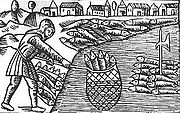
Staple food
A staple food is one that is eaten regularly and in such quantities that it constitutes a dominant portion of a diet, and that supplies a high proportion of energy and nutrient needs. Most people live on a diet based on one or more staples...
source since 3000 B.C. In Roman
Ancient Rome
Ancient Rome was a thriving civilization that grew on the Italian Peninsula as early as the 8th century BC. Located along the Mediterranean Sea and centered on the city of Rome, it expanded to one of the largest empires in the ancient world....
times, anchovies were the base for the fermented fish sauce called garum
Garum
Garum, similar to liquamen, was a type of fermented fish sauce condiment that was an essential flavour in Ancient Roman cooking, the supreme condiment....
. This staple of cuisine was produced in industrial quantities and transported over long distances.
Fishing for sardela or sardina (Sardina pilchardus) is an ongoing activity on the Croatia
Croatia
Croatia , officially the Republic of Croatia , is a unitary democratic parliamentary republic in Europe at the crossroads of the Mitteleuropa, the Balkans, and the Mediterranean. Its capital and largest city is Zagreb. The country is divided into 20 counties and the city of Zagreb. Croatia covers ...
n Adriatic coasts of Dalmatia
Dalmatia
Dalmatia is a historical region on the eastern coast of the Adriatic Sea. It stretches from the island of Rab in the northwest to the Bay of Kotor in the southeast. The hinterland, the Dalmatian Zagora, ranges from fifty kilometers in width in the north to just a few kilometers in the south....
and Istria
Istria
Istria , formerly Histria , is the largest peninsula in the Adriatic Sea. The peninsula is located at the head of the Adriatic between the Gulf of Trieste and the Bay of Kvarner...
. It traces its roots back thousands of years. The region was then largely a Venetian
Republic of Venice
The Republic of Venice or Venetian Republic was a state originating from the city of Venice in Northeastern Italy. It existed for over a millennium, from the late 7th century until 1797. It was formally known as the Most Serene Republic of Venice and is often referred to as La Serenissima, in...
dominion, part of the Roman Empire
Roman Empire
The Roman Empire was the post-Republican period of the ancient Roman civilization, characterised by an autocratic form of government and large territorial holdings in Europe and around the Mediterranean....
. The area has always been sustained through fishing mainly sardines. Along the coast towns still promote the traditional practice of fishing by lateen
Lateen
A lateen or latin-rig is a triangular sail set on a long yard mounted at an angle on the mast, and running in a fore-and-aft direction....
sail boats for tourism and festivals.
Pilchard fishing and processing thrived in Cornwall
Cornwall
Cornwall is a unitary authority and ceremonial county of England, within the United Kingdom. It is bordered to the north and west by the Celtic Sea, to the south by the English Channel, and to the east by the county of Devon, over the River Tamar. Cornwall has a population of , and covers an area of...
between 1750 and 1880, after which stocks went into an almost terminal decline. Recently (2007) stocks have been improving. The industry has featured in many works of art, including Stanhope Forbes
Stanhope Forbes
Stanhope Alexander Forbes R.A., , was an artist and member of the influential Newlyn school of painters...
and other Newlyn School
Newlyn School
The Newlyn School is a term used to describe an art colony of artists based in or near to Newlyn, a fishing village adjacent to Penzance, Cornwall, from the 1880s until the early 20th century. The establishment of the Newlyn School was reminiscent of the Barbizon School in France, where artists...
artists.
Contemporary
Traditional commercial fisheriesCommercial fishing
Commercial fishing is the activity of catching fish and other seafood for commercial profit, mostly from wild fisheries. It provides a large quantity of food to many countries around the world, but those who practice it as an industry must often pursue fish far into the ocean under adverse conditions...
were directed towards high value ocean predators such as cod
Cod
Cod is the common name for genus Gadus, belonging to the family Gadidae, and is also used in the common name for various other fishes. Cod is a popular food with a mild flavor, low fat content and a dense, flaky white flesh. Cod livers are processed to make cod liver oil, an important source of...
, rockfish
Rockfish
Rockfish may refer to one of the following fishes:* One of several species in the Sebastes genus of the Sebastidae family, including the Shortraker rockfish, Rougheye rockfish, Blue rockfish, Yellow tail rockfish and many others....
and tuna
Tuna
Tuna is a salt water fish from the family Scombridae, mostly in the genus Thunnus. Tuna are fast swimmers, and some species are capable of speeds of . Unlike most fish, which have white flesh, the muscle tissue of tuna ranges from pink to dark red. The red coloration derives from myoglobin, an...
, rather than humble forage fish. As technologies developed, fisheries became so effective at locating and catching predator fish that many of the stocks collapsed. The industry compensated by turning to species lower in the food chain.
In former times, forage fish were more difficult to fish profitably, and were a small part of the global marine fisheries. But modern industrial fishing technologies have enabled the removal of increasing quantities. Industrial-scale forage fish fisheries need large scale landings of fish to return profits. They are dominated by a small number of corporate fishing and processing companies.

Fishfinder
A fishfinder is an instrument used to locate fish underwater by detecting reflected pulses of sound energy, as in SONAR. A modern fishfinder displays measurements of reflected sound on a graphical display, allowing an operator to interpret information to locate schools of fish, underwater debris,...
s and from above with spotter planes. Once located, they are scooped out of the water using highly efficient nets, such as purse seines, which remove most of the school.
Spawning patterns in forage fish are highly predictable. Some fisheries use knowledge of these patterns to harvest the forage species as they come together to spawn, removing the fish before they have actually spawned. Fishing during spawning periods or at other times when forage fish amass in large numbers can also be a blow to predators. Many predators, such as whales, tuna and sharks, have evolved to migrate long distances to specific sites for feeding and breeding. Their survival hinges on their finding these forage schools at their feeding grounds. The great ocean predators find that, no matter how they are adapted for speed, size, endurance or stealth, they are on the losing side when faced with the machinery of contemporary industrial fishing.

The Peruvian anchoveta fishery is now the biggest in the world (10.7 million tonnes in 2004), while the Alaskan pollock fishery in the Bering Sea
Bering Sea
The Bering Sea is a marginal sea of the Pacific Ocean. It comprises a deep water basin, which then rises through a narrow slope into the shallower water above the continental shelves....
is the largest single species fishery in the world (3 million tonnes). The Alaskan pollock is said to be the largest remaining single species source of palatable fish in the world. However, the biomass of pollock has declined in recent years, perhaps spelling trouble for both the Bering Sea
Bering Sea
The Bering Sea is a marginal sea of the Pacific Ocean. It comprises a deep water basin, which then rises through a narrow slope into the shallower water above the continental shelves....
ecosystem and the commercial fishery it supports. Acoustic surveys by NOAA indicate that the 2008 pollock population is almost 50 percent lower than last year's survey levels. Some scientists think this decline in Alaska pollock could repeat the collapse experienced by Atlantic cod
Atlantic cod
The Atlantic cod, Gadus morhua, is a well-known demersal food fish belonging to the family Gadidae. It is also commercially known as cod, codling or haberdine....
, which could have negative consequences for the entire Bering Sea ecosystem. Salmon, halibut, endangered Steller sea lions, fur seals, and humpback whales eat pollock and depend on healthy populations to sustain themselves.
Use as animal feed
Eighty percent of the forage fish caught are fed to animals. Ninety percent is processed into fishmeal and fish oilFish oil
Fish oil is oil derived from the tissues of oily fish. Fish oils contain the omega-3 fatty acids eicosapentaenoic acid , and docosahexaenoic acid , precursors of certain eicosanoids that are known to reduce inflammation throughout the body, and are thought to have many health benefits.Fish do not...
. Of this, 46 percent was fed to farmed fish, 24 percent to pigs, and 22 percent to poultry (2002). Six times the weight of forage fish is fed to pigs and poultry alone than the entire seafood consumption of the U.S. market.
According to Turchini and De Silva (2008), another 2.5 million tonnes of the annual forage fish catch is consumed by the global cat food
Cat food
Cat food is food intended for consumption by cats.As with all species, cats have requirements for specific dietary nutrients, rather than ingredients. Certain nutrients, including many vitamins and amino acids, are degraded by the temperatures, pressures and chemical treatments used during...
industry. In Australia, pet cats eat 13.7 kilograms of fish a year compared to the 11 kilograms eaten by the average Australian. The pet food industry is increasingly marketing premium and super-premium products, when different raw materials, such as the by-products of the fish filleting industry, could be used instead.
Environmental issues
A recent study (2008) by fisheries scientists Jacqueline Alder, Daniel PaulyDaniel Pauly
Daniel Pauly is a French-born marine biologist, well-known for his work in studying human impacts on global fisheries. He is a professor and the project leader of the Sea Around Us Project at the Fisheries Centre at the University of British Columbia. He also served as Director of the Fisheries...
and colleagues is the product of a nine-year Sea Around Us Project
Sea Around Us Project
The Sea Around Us Project is an international research group based at the University of British Columbia Fisheries Centre that is devoted to studying the impacts of fisheries on the world's marine ecosystems...
. The study concludes that...
In lakes and rivers
Forage fish also inhabit freshwater habitats, such as lakes and rivers, where they serve as food for larger freshwater predators. Usually smaller than 15 centimetres (6 in) in length, these small bait fishBait fish
Bait fish are small fish caught for use as bait to attract large predatory fish, particularly game fish. Species used are typically those that are common and breed rapidly, making them easy to catch and in regular supply. Examples of marine bait fish are anchovies, halfbeaks such as ballyhoo, and...
make up most of the fish found in lakes and rivers. The minnow
Minnow
Minnow is a general term used to refer to small freshwater and saltwater fish, especially those used as bait fish or for fishing bait. More specifically, it refers to small freshwater fish of the carp family.-True minnows:...
family alone, consisting of minnow
Minnow
Minnow is a general term used to refer to small freshwater and saltwater fish, especially those used as bait fish or for fishing bait. More specifically, it refers to small freshwater fish of the carp family.-True minnows:...
s, chub
Chub
The European chub , sometimes called the round chub, fat chub, chevin, pollard or simply "the" chub, is a freshwater fish of the family Cyprinidae...
s, shiner
Shiner
Shiner may refer to:*Shiner , an Atlanta based design firm*Esther Shiner, a deceased Toronto municipal politician* Lewis Shiner , an American writer*Shiner *Shiner, Texas*Shiner , a line of beers brewed by the Spoetzl Brewery...
s and dace
Dace
A dace is any of a number of species of small fish. The unmodified name is usually a reference to the Common Dace . This, like most fishes called "daces", belongs to the family Cyprinidae, mostly in subfamily Leuciscinae....
s, consists of more than fifty species. Other freshwater forage fish include suckers
Catostomidae
Catostomidae is the sucker family of the order Cypriniformes. There are 80 species in this family of freshwater fishes. Catostomidae are found in North America, east central China, and eastern Siberia...
, killifish
Killifish
A killifish is any of various oviparous cyprinodontiform fish . Altogether, there are some 1270 different species of killifish, the biggest family being Rivulidae, containing more than 320 species...
, shad
Shad
The shads or river herrings comprise the genus Alosa, fish related to herring in the family Clupeidae. They are distinct from others in that family by having a deeper body and spawning in rivers. The several species frequent different areas on both sides of the Atlantic Ocean, Mediterranean Sea....
, bony fish
Osteichthyes
Osteichthyes , also called bony fish, are a taxonomic group of fish that have bony, as opposed to cartilaginous, skeletons. The vast majority of fish are osteichthyes, which is an extremely diverse and abundant group consisting of over 29,000 species...
as well as fish of the sunfish family
Centrarchidae
The sunfishes are a family of freshwater ray-finned fish belonging to the order Perciformes. The type genus is Centrarchus . The family's 27 species includes many fishes familiar to North Americans, including the rock bass, largemouth bass, bluegill, pumpkinseed, and crappies...
, excluding black bass
Black bass
Micropterus , is a genus of freshwater fish in the sunfish family of order Perciformes. The type species is M. dolomieu, the smallmouth bass...
es and crappie
Crappie
Crappie is a genus of freshwater fish in the sunfish family of order Perciformes. The type species is P. annularis, the white crappie...
, and smaller species of the carp family. There are also anadromous forage fish, such as eulachon
Eulachon
The eulachon, also oolichan, hooligan, ooligan, or candlefish, is a small anadromous ocean fish, Thaleichthys pacificus, a smelt found along the Pacific coast of North America from northern California to Alaska....
.
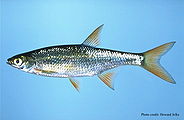 |
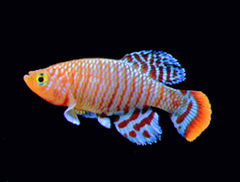 |
 |
| Golden shiner | Killifish | Southern redbelly dace |
 |
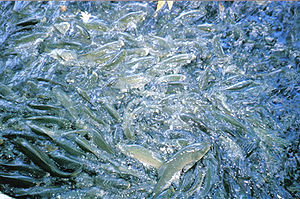 |
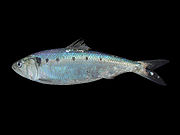 |
| Chinese minnow | Swarm of carp | Twaite shad |
Within any fresh or saltwater
Seawater
Seawater is water from a sea or ocean. On average, seawater in the world's oceans has a salinity of about 3.5% . This means that every kilogram of seawater has approximately of dissolved salts . The average density of seawater at the ocean surface is 1.025 g/ml...
ecosystem, there will always be both desirable and undesirable fishes, and this varies from country to country, and often from region to region within a country. Sport fishermen
Recreational fishing
Recreational fishing, also called sport fishing, is fishing for pleasure or competition. It can be contrasted with commercial fishing, which is fishing for profit, or subsistence fishing, which is fishing for survival....
divide freshwater predators of forage fish into those:
- which have a good fighting ability and are good to eat, called sport (or game) fishGame fishGame fish are fish pursued for sport by recreational anglers. They can be freshwater or marine fish. Game fish can be eaten after being caught, though increasingly anglers practise catch and release to improve fish populations. Some game fish are also targeted commercially, particularly...
. - the other less desirable fish, called rough fishRough fishRough fish is a term used by U.S. state agencies and U.S. anglers to describe fish that are less desirable to sport anglers within a limited region. The term usually refers to larger fish species that are not commonly eaten, are too rare to be commonly encountered, or are not sought after by...
in North America and coarse fishCoarse fishingCoarse fishing is a term used in the United Kingdom and Ireland for angling for coarse fish, which are those types of freshwater fish other than game fish . The sport and the techniques used are particularly popular in the United Kingdom and mainland Europe.-History:The term "coarse fishing"...
in Britain
Rough or coarse fish usually refers to fish that are not commonly eaten, not sought after for sporting reasons, or have become invasive species reducing the populations of desirable fish. They compete for forage fish with the more popular sport fish. They are often regarded as a nuisance, and are not usually protected by game laws. Forage fish generally are not considered rough or coarse fish because of their usefulness as bait.
The term rough fish is used by U.S. state agencies and anglers to describe undesirable predator fish. In North America, anglers fish for salmon
Salmon
Salmon is the common name for several species of fish in the family Salmonidae. Several other fish in the same family are called trout; the difference is often said to be that salmon migrate and trout are resident, but this distinction does not strictly hold true...
, trout
Trout
Trout is the name for a number of species of freshwater and saltwater fish belonging to the Salmoninae subfamily of the family Salmonidae. Salmon belong to the same family as trout. Most salmon species spend almost all their lives in salt water...
, bass
Bass (fish)
Bass is a name shared by many different species of popular gamefish. The term encompasses both freshwater and marine species. All belong to the large order Perciformes, or perch-like fishes, and in fact the word bass comes from Middle English bars, meaning "perch."-Types of basses:*The temperate...
, pike
Esox
Esox is a genus of freshwater fish, the only living genus in the family Esocidae — the esocids which were endemic to North America, Europe and Eurasia during the Paleogene through present.The type species is E. lucius, the northern pike...
, catfish
Catfish
Catfishes are a diverse group of ray-finned fish. Named for their prominent barbels, which resemble a cat's whiskers, catfish range in size and behavior from the heaviest and longest, the Mekong giant catfish from Southeast Asia and the second longest, the wels catfish of Eurasia, to detritivores...
, walleye
Walleye
Walleye is a freshwater perciform fish native to most of Canada and to the northern United States. It is a North American close relative of the European pikeperch...
and muskellunge
Muskellunge
A muskellunge , also known as a muskelunge, muscallonge, milliganong, or maskinonge , is a large, relatively uncommon freshwater fish of North America. Muskellunge are the largest member of the pike family, Esocidae...
. The smallest fish are called panfish
Panfish
A panfish, also spelled pan-fish or pan fish, is an edible game fish that usually doesn't outgrow the size of a frying pan. The term is also commonly used by anglers to refer to any small catch that will fit in a pan, but is large enough to be legal. However its definition and usage varies with...
, because they can fit in a standard cooking pan. Some examples are crappie
Crappie
Crappie is a genus of freshwater fish in the sunfish family of order Perciformes. The type species is P. annularis, the white crappie...
s, rock bass
Rock bass
The rock bass , also known as the rock perch, goggle-eye, or red eye is a species of freshwater fish in the sunfish family of order Perciformes. They are similar in appearance to smallmouth bass but are usually quite a bit smaller...
, perch
Perch
Perch is a common name for fish of the genus Perca, freshwater gamefish belonging to the family Percidae. The perch, of which there are three species in different geographical areas, lend their name to a large order of vertebrates: the Perciformes, from the Greek perke meaning spotted, and the...
, bluegill
Bluegill
The Bluegill is a species of freshwater fish sometimes referred to as bream, brim, or copper nose. It is a member of the sunfish family Centrarchidae of the order Perciformes.-Range and distribution:...
and sunfish
Lepomis
Lepomis is a genus of freshwater fish in the sunfish family of order Perciformes. The most recognizable species of the sixteen in this genus is the Bluegill....
.
The term coarse fish originated in the United Kingdom in the early 19th century. Prior to that time, recreational fishing was the sport of the gentry
Gentry
Gentry denotes "well-born and well-bred people" of high social class, especially in the past....
, who angled for trout
Trout
Trout is the name for a number of species of freshwater and saltwater fish belonging to the Salmoninae subfamily of the family Salmonidae. Salmon belong to the same family as trout. Most salmon species spend almost all their lives in salt water...
and salmon
Salmon
Salmon is the common name for several species of fish in the family Salmonidae. Several other fish in the same family are called trout; the difference is often said to be that salmon migrate and trout are resident, but this distinction does not strictly hold true...
which they called "game fish". Fish other than game fish were disdained as "coarse fish". These days, "game fish" refers to Salmonids (other than grayling) — that is, salmon
Salmon
Salmon is the common name for several species of fish in the family Salmonidae. Several other fish in the same family are called trout; the difference is often said to be that salmon migrate and trout are resident, but this distinction does not strictly hold true...
, trout
Trout
Trout is the name for a number of species of freshwater and saltwater fish belonging to the Salmoninae subfamily of the family Salmonidae. Salmon belong to the same family as trout. Most salmon species spend almost all their lives in salt water...
and char
Salvelinus
Salvelinus is a genus of salmonid fish often called char or charr; some species are called "trout". Salvelinus is a member of the Salmoninae subfamily of the Salmonidae family. Charr may be identified by light cream pink or red spots over a darker body. Scales tend to be small, with 115-200 along...
. Coarse fish are made up mostly of the larger species of Cyprinid
Cyprinid
The family Cyprinidae, from the Ancient Greek kyprînos , consists of the carps, the true minnows, and their relatives . Commonly called the carp family or the minnow family, its members are also known as cyprinids...
s (carp
Carp
Carp are various species of oily freshwater fish of the family Cyprinidae, a very large group of fish native to Europe and Asia. The cypriniformes are traditionally grouped with the Characiformes, Siluriformes and Gymnotiformes to create the superorder Ostariophysi, since these groups have certain...
, roach
Rutilus
Rutilus is a genus of fishes in the family Cyprinidae, commonly called roaches. Locally, the name "roach" without any further qualifiers is also used for particular species, particularly the Common Roach Rutilus (Latin for "shining, red, golden, auburn") is a genus of fishes in the family...
, bream) as well as pike
Esox
Esox is a genus of freshwater fish, the only living genus in the family Esocidae — the esocids which were endemic to North America, Europe and Eurasia during the Paleogene through present.The type species is E. lucius, the northern pike...
, catfish
Catfish
Catfishes are a diverse group of ray-finned fish. Named for their prominent barbels, which resemble a cat's whiskers, catfish range in size and behavior from the heaviest and longest, the Mekong giant catfish from Southeast Asia and the second longest, the wels catfish of Eurasia, to detritivores...
, gar
Gar
In American English the name gar is strictly applied to members of the Lepisosteidae, a family including seven living species of fish in two genera that inhabit fresh, brackish, and occasionally marine, waters of eastern North America, Central America, and the Caribbean islands.-Etymology:In...
and lamprey
Lamprey
Lampreys are a family of jawless fish, whose adults are characterized by a toothed, funnel-like sucking mouth. Translated from an admixture of Latin and Greek, lamprey means stone lickers...
. Coarse fish are no longer disdained; indeed, fishing for coarse fish
Coarse fishing
Coarse fishing is a term used in the United Kingdom and Ireland for angling for coarse fish, which are those types of freshwater fish other than game fish . The sport and the techniques used are particularly popular in the United Kingdom and mainland Europe.-History:The term "coarse fishing"...
has become a popular pastime.
 |
 |
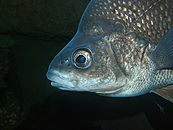 |
| Brook trout | Black crappie | Macquarie perch |
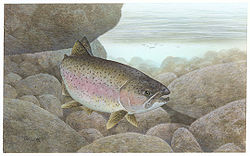 |
 |
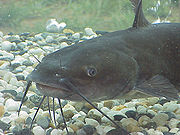 |
| Rainbow trout | Pink salmon | Channel catfish |
Bait and feeder fish
Forage fish are sometimes referred to as bait fish or feeder fish. Bait fishBait fish
Bait fish are small fish caught for use as bait to attract large predatory fish, particularly game fish. Species used are typically those that are common and breed rapidly, making them easy to catch and in regular supply. Examples of marine bait fish are anchovies, halfbeaks such as ballyhoo, and...
is a term used particularly by recreational fishermen, although commercial fisherman also catch fish to bait longlines and traps. Forage fish is a fisheries term, and is used in the context of fisheries. Bait fish, by contrast, are fish that are caught by humans to use as bait for other fish. The terms overlap in the sense that most bait fish are also forage fish, and vice versa. Feeder fish
Feeder fish
Feeder fish is the generic name for certain types of inexpensive fish commonly fed as live prey to captive animals such as sharks, turtles and some other fish such as oscars.-Advantages of using feeder fish:...
is a term used particularly in the context of fish aquarium
Aquarium
An aquarium is a vivarium consisting of at least one transparent side in which water-dwelling plants or animals are kept. Fishkeepers use aquaria to keep fish, invertebrates, amphibians, marine mammals, turtles, and aquatic plants...
s. It refers essentially to the same concept as forage fish, small fish that are eaten by larger fish, but the term is adapted to the particular requirements of working with fish in aquariums.
Timeline
- 2006: The U.S. National Coalition for Marine ConservationNational Coalition for Marine ConservationFounded in 1973 by fishermen, the National Coalition for Marine Conservation is the USA's oldest public advocacy group dedicated exclusively to conserving ocean fish and their environment. The NCMC's mission is to build awareness of the threats to USA marine fisheries and convince policy-makers...
asks U.S. fishery managers to put "Forage First!". Their campaign was launched with the publication of their report, Taking the Bait: Are America’s Fisheries Out-competing Predators for their Prey?, available at cost to the U. S. fishing industry, encouraging fishery managers to protect predator-prey relationships as a first step toward an ecosystem based approach to fishery management. - 2009: The international Lenfest Forage Fish Task Force is established to develop workable management plans for tackling the depletion of forage fish.
External links
- Herring Research: Using Acoustics to Count Fish.
- Sanders, Michael (1995) Impacts of predator-prey relationships on harvesting strategies and management FAOFãoFão is a town in Esposende Municipality in Portugal....
. - Daniel Pauley at Fish Forever – Youtube: Pauley talks about his "epiphany" about directly eating anchovies.

